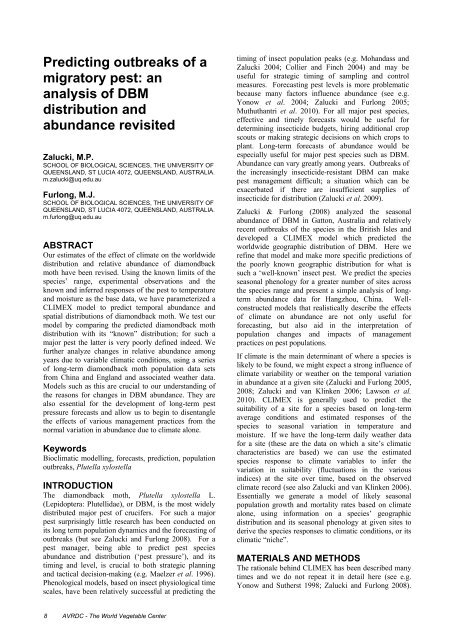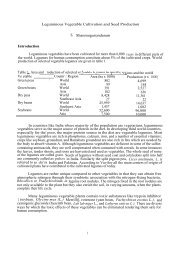Management of the Diamondback Moth and Other Crucifer Insect ...
Management of the Diamondback Moth and Other Crucifer Insect ...
Management of the Diamondback Moth and Other Crucifer Insect ...
Create successful ePaper yourself
Turn your PDF publications into a flip-book with our unique Google optimized e-Paper software.
Predicting outbreaks <strong>of</strong> amigratory pest: ananalysis <strong>of</strong> DBMdistribution <strong>and</strong>abundance revisitedZalucki, M.P.SCHOOL OF BIOLOGICAL SCIENCES, THE UNIVERSITY OFQUEENSLAND, ST LUCIA 4072, QUEENSLAND, AUSTRALIA.m.zalucki@uq.edu.auFurlong, M.J.SCHOOL OF BIOLOGICAL SCIENCES, THE UNIVERSITY OFQUEENSLAND, ST LUCIA 4072, QUEENSLAND, AUSTRALIA.m.furlong@uq.edu.auABSTRACTOur estimates <strong>of</strong> <strong>the</strong> effect <strong>of</strong> climate on <strong>the</strong> worldwidedistribution <strong>and</strong> relative abundance <strong>of</strong> diamondbackmoth have been revised. Using <strong>the</strong> known limits <strong>of</strong> <strong>the</strong>species’ range, experimental observations <strong>and</strong> <strong>the</strong>known <strong>and</strong> inferred responses <strong>of</strong> <strong>the</strong> pest to temperature<strong>and</strong> moisture as <strong>the</strong> base data, we have parameterized aCLIMEX model to predict temporal abundance <strong>and</strong>spatial distributions <strong>of</strong> diamondback moth. We test ourmodel by comparing <strong>the</strong> predicted diamondback mothdistribution with its “known” distribution; for such amajor pest <strong>the</strong> latter is very poorly defined indeed. Wefur<strong>the</strong>r analyze changes in relative abundance amongyears due to variable climatic conditions, using a series<strong>of</strong> long-term diamondback moth population data setsfrom China <strong>and</strong> Engl<strong>and</strong> <strong>and</strong> associated wea<strong>the</strong>r data.Models such as this are crucial to our underst<strong>and</strong>ing <strong>of</strong><strong>the</strong> reasons for changes in DBM abundance. They arealso essential for <strong>the</strong> development <strong>of</strong> long-term pestpressure forecasts <strong>and</strong> allow us to begin to disentangle<strong>the</strong> effects <strong>of</strong> various management practices from <strong>the</strong>normal variation in abundance due to climate alone.KeywordsBioclimatic modelling, forecasts, prediction, populationoutbreaks, Plutella xylostellaINTRODUCTIONThe diamondback moth, Plutella xylostella L.(Lepidoptera: Plutellidae), or DBM, is <strong>the</strong> most widelydistributed major pest <strong>of</strong> crucifers. For such a majorpest surprisingly little research has been conducted onits long term population dynamics <strong>and</strong> <strong>the</strong> forecasting <strong>of</strong>outbreaks (but see Zalucki <strong>and</strong> Furlong 2008). For apest manager, being able to predict pest speciesabundance <strong>and</strong> distribution (‘pest pressure’), <strong>and</strong> itstiming <strong>and</strong> level, is crucial to both strategic planning<strong>and</strong> tactical decision-making (e.g. Maelzer et al. 1996).Phenological models, based on insect physiological timescales, have been relatively successful at predicting <strong>the</strong>timing <strong>of</strong> insect population peaks (e.g. Moh<strong>and</strong>ass <strong>and</strong>Zalucki 2004; Collier <strong>and</strong> Finch 2004) <strong>and</strong> may beuseful for strategic timing <strong>of</strong> sampling <strong>and</strong> controlmeasures. Forecasting pest levels is more problematicbecause many factors influence abundance (see e.g.Yonow et al. 2004; Zalucki <strong>and</strong> Furlong 2005;Muthuthantri et al. 2010). For all major pest species,effective <strong>and</strong> timely forecasts would be useful fordetermining insecticide budgets, hiring additional cropscouts or making strategic decisions on which crops toplant. Long-term forecasts <strong>of</strong> abundance would beespecially useful for major pest species such as DBM.Abundance can vary greatly among years. Outbreaks <strong>of</strong><strong>the</strong> increasingly insecticide-resistant DBM can makepest management difficult; a situation which can beexacerbated if <strong>the</strong>re are insufficient supplies <strong>of</strong>insecticide for distribution (Zalucki et al. 2009).Zalucki & Furlong (2008) analyzed <strong>the</strong> seasonalabundance <strong>of</strong> DBM in Gatton, Australia <strong>and</strong> relativelyrecent outbreaks <strong>of</strong> <strong>the</strong> species in <strong>the</strong> British Isles <strong>and</strong>developed a CLIMEX model which predicted <strong>the</strong>worldwide geographic distribution <strong>of</strong> DBM. Here werefine that model <strong>and</strong> make more specific predictions <strong>of</strong><strong>the</strong> poorly known geographic distribution for what issuch a ‘well-known’ insect pest. We predict <strong>the</strong> speciesseasonal phenology for a greater number <strong>of</strong> sites across<strong>the</strong> species range <strong>and</strong> present a simple analysis <strong>of</strong> longtermabundance data for Hangzhou, China. Wellconstructedmodels that realistically describe <strong>the</strong> effects<strong>of</strong> climate on abundance are not only useful forforecasting, but also aid in <strong>the</strong> interpretation <strong>of</strong>population changes <strong>and</strong> impacts <strong>of</strong> managementpractices on pest populations.If climate is <strong>the</strong> main determinant <strong>of</strong> where a species islikely to be found, we might expect a strong influence <strong>of</strong>climate variability or wea<strong>the</strong>r on <strong>the</strong> temporal variationin abundance at a given site (Zalucki <strong>and</strong> Furlong 2005,2008; Zalucki <strong>and</strong> van Klinken 2006; Lawson et al.2010). CLIMEX is generally used to predict <strong>the</strong>suitability <strong>of</strong> a site for a species based on long-termaverage conditions <strong>and</strong> estimated responses <strong>of</strong> <strong>the</strong>species to seasonal variation in temperature <strong>and</strong>moisture. If we have <strong>the</strong> long-term daily wea<strong>the</strong>r datafor a site (<strong>the</strong>se are <strong>the</strong> data on which a site’s climaticcharacteristics are based) we can use <strong>the</strong> estimatedspecies response to climate variables to infer <strong>the</strong>variation in suitability (fluctuations in <strong>the</strong> variousindices) at <strong>the</strong> site over time, based on <strong>the</strong> observedclimate record (see also Zalucki <strong>and</strong> van Klinken 2006).Essentially we generate a model <strong>of</strong> likely seasonalpopulation growth <strong>and</strong> mortality rates based on climatealone, using information on a species’ geographicdistribution <strong>and</strong> its seasonal phenology at given sites toderive <strong>the</strong> species responses to climatic conditions, or itsclimatic “niche”.MATERIALS AND METHODSThe rationale behind CLIMEX has been described manytimes <strong>and</strong> we do not repeat it in detail here (see e.g.Yonow <strong>and</strong> Su<strong>the</strong>rst 1998; Zalucki <strong>and</strong> Furlong 2008).8 AVRDC - The World Vegetable Center
















